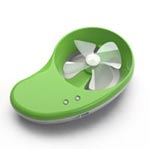 I visited the Greener Gadgets conference on Friday and attended the panel on new forms of mobile renewable energy. Among the presenters, one talked about a mini-windmill you could strap on your arm to charge your cellphone and another spoke of longer-life laptop battery.
I visited the Greener Gadgets conference on Friday and attended the panel on new forms of mobile renewable energy. Among the presenters, one talked about a mini-windmill you could strap on your arm to charge your cellphone and another spoke of longer-life laptop battery.
To get the windmill to charge your cellphone for a whopping, um, four minutes of talk-time, according to the HYmini webpage, you need 20 minutes of a steady 19 mph wind. You get the wind, say, by attaching it to your bike handlebars or wearing it on your arm when you go snowboarding.
On the other hand, Boston Power’s seemingly more boring and conventional lithium ion battery, newly introduced and dubbed the “Sonata,” does nothing more revolutionary than last for three years and charge quickly.
Which is the greener product? You got a windmill and a laptop accessory. A no-brainer, right?
But here’s the thing. The mini-windmill, when it comes down to it, is essentially a toy that does not replace but is bought in addition to the regular plug-in cellphone charger. And the fate of this impractical gadget will more than likely be its owner’s desk drawer, not a place we want to be storing precious planetary resources.
The long life of the Boston Power battery, on the other hand, depending on usage, allows it to replace two or three conventional laptop batteries. The durability of the Sonata means less toxicity, less metal pollution and less resource use, something that is good for the planet and something that customers already want.
The point is that if your goal is to truly create a truly sustainable product, make sure you are leveraging consumer demand to create green practices, not leveraging ostensible green practices to create consumer demand.